How to Develop a Healthcare App: an Ultimate Guide
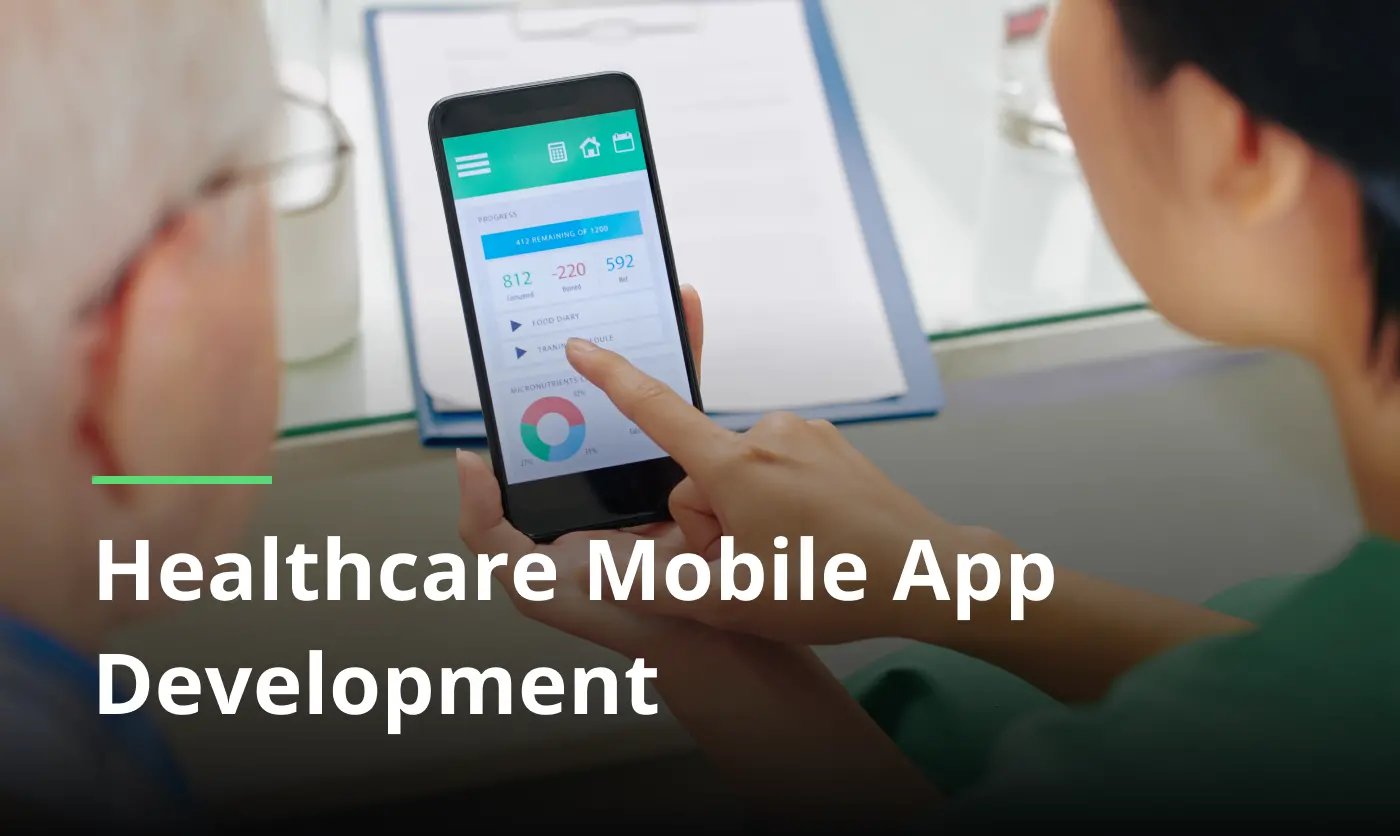
Healthcare app development holds a prime position in transforming the manner of patient support delivery. We tasked ourselves to provide an overview of the new applications that have restructured the industry. Beyond just tools, these innovations are lifelines that bridge the divide between practitioners and care recipients. A telemedicine application and a wearable tracker lead the charge toward a more interconnected and wellness-conscious world.
The realm of medical app development continues to create waves, that’s why, preparing this comprehensive synopsis, we took into account the roadmap for building a distinctive and highly useful program, the functionalities that are keys to customers’ acceptance, and the costs of services.
Healthcare mobile app development is becoming indispensable as healing institutions embrace healthcare solutions to optimize their workflows. Quietly revolutionizing the sector, digital health apps reduce wait times at hospitals and give you immediate access to your therapeutic history. Read further to explore the instruments that pave the way for the future of medicine.
What is a healthcare application?
About 43% of people give their preferences to one or another medical program. While some are basic utilities that monitor heartbeat, advise how to follow a body-conscious style, encourage the adoption of good habits like eating nutritiously or drinking water regularly, others are life savers, widely authorized by hospitals, recovery and rehabilitation centers and insurance companies.
Talking about the extent of provisions existing, it is astonishingly wide since the simple interface on iPhones called Fitness is related to this type of web product as well as specialized offerings like Apocrates, MyChart, Alver Cor. The target audience varies; ones are approached only by specialists who use it to define the dosage of drugs to prescribe, control devices and even manage the facility’s inventories, the rest are available for all groups.
How to create a medical app: action-by-action recap
Crafting a virtual tool is a triple threat: it takes imagination, precision engineering and strict compliance with laws. Given the practical side of custom application development today, suppliers are moving towards individualized solutions to deal with users’ issues. So why not peel back the layers of the steps to get your endeavor on its feet?
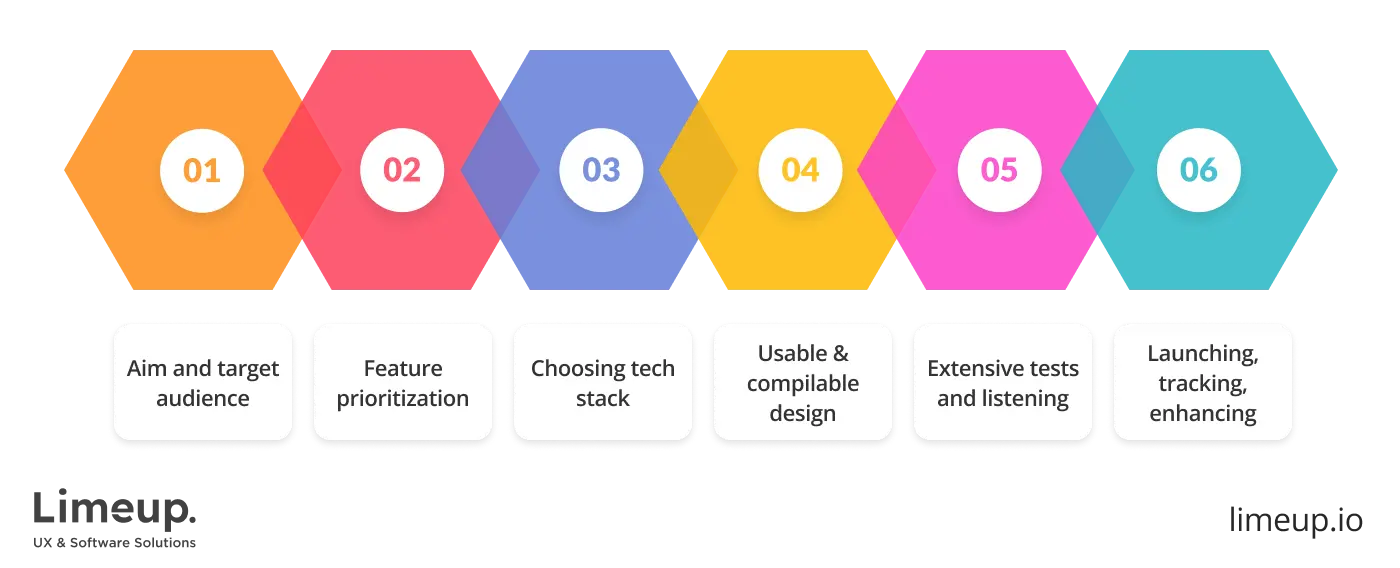
Specify the aim and buying persona. A recipe for project success begins by knowing why you are doing it and what is at the center of your efforts. Is it for clinics to become more efficient, help patients interact or assist with remote healing guidance? Only when these points are known will digital health app development bring affordable and relevant outcomes.
Just as paramount is identifying your clientele: recipients, physicians, support staff, you name it. This idea dovetails with reports indicating that 64% of therapy participants prefer online appointment scheduling instruments and record admission, spotlighting a lucrative opportunity.
Prioritize characteristics that add value. Well-designed carry outs have tangible perks like organized meetings with ease and cut the waiting hours while embedding remote consultation capabilities and safeguarding confidential content, adhering strictly to HIPAA and GDPR requirements.
Too many bells and whistles may confuse your patrons, so stick to functions that address specific concerns. With a well-thought-out custom healthcare app development strategy, components may be layered as new needs arise.
Choose the right technology stack. A well-chosen tech suite is the secret sauce of any venture’s triumph. Swift or Kotlin make implementations soar, and React Native or Flutter are the go-to for cross-platform operational excellence. Cloud integration introduces a tier of broadening capacity and instant archive intake.
Lay out for usability and conformity. At the backbone of building a health app is its interface that feels natural and effortless. Simultaneously, conforming to the specific regulations is non-negotiable; going the extra mile in rule abidance is a proven technique to avoid hefty penalties and arouse trust.
Test extensively and listen closely. Proper examination before deploying what makes the outputs impeccable. As you look into conducting functional and security audits, it is crucial to iron out any kinks or vulnerabilities. A golden insight may come from rolling out a pilot with real analyzers who will tune through a fine tooth in elevating the UX.
Launch, observe, enhance. Supervising important key performance metrics you should watch over the engagement, retention and error logs. Frequent updates and case enhancements based on feedback obtained from those who check it will keep your undertaking on top.
What are the key features of healthcare app development?
Infused with purpose, interactive offerings aim to empower patients, providers and administrators. What makes them the cream of the crop is the properties that give them an edge over the rest. Unearth the core attributes behind them:
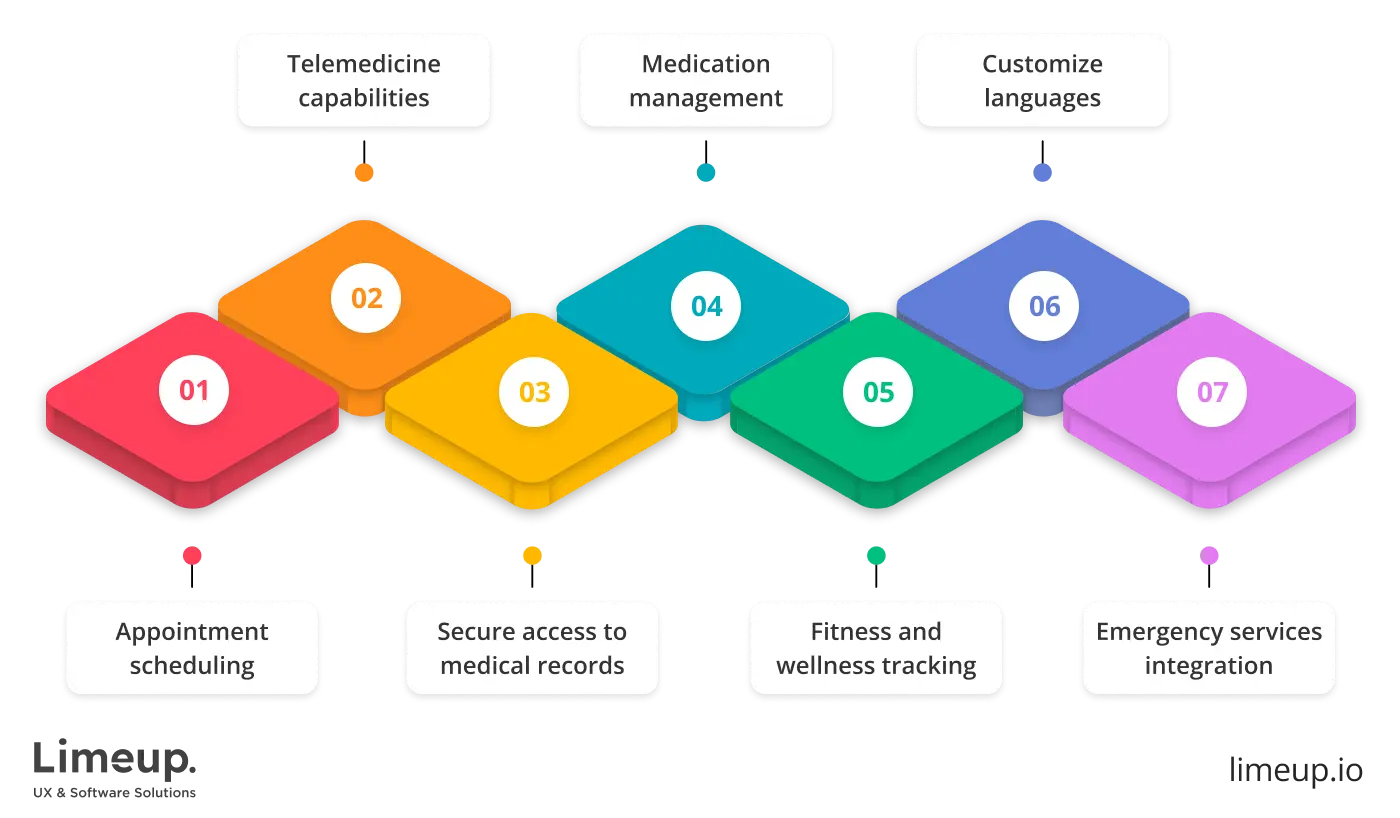
No more endless loops of hold music to make that visit to your doctor for yourself. Data reveals that 77% of patients lean toward innovations that simplify meeting handling. Such elements improve the resourcefulness for all consumers, cutting down on no-shows and boosting efficiency. Calendar syncing and reminder systems act as subtle prompts for program enrollers to stay on top of their needs.
Sophisticated healthcare app development solutions facilitate eliminating geographical barriers and resource optimizations. Video calls, instant chat options and measurement of symptoms through AI make for elevated curation of chronic conditions and emergencies.
Providing high-quality treatment relies on defensive particulars as its lifeblood and the software that collects an individual’s diagnostic background. Test results and easily reachable instructions are indispensable assets. Encrypted repository storage and multi-factor authorization make things quick and also add another layer of protection.
Evidence exposes that those who actively engage with their case health histories are 60% more likely to follow their treatment plans, making this characteristic a key factor in custom health app development that improves soundness.
No one’s perfect and forgetfulness is part of being human, but when it involves taking medicine, it may lead to serious consequences. Then there are resources that remind you of pills to take, let you note dosage consumption and connect with the nearest pharmacy. Many of the most ambitious types use Artificial Intelligence to identify potential drug conflicts and avoid other complications involving existing prescriptions or allergies.
Preventative measures are your starting point for a holistic lifestyle. Workout tracking utilities — programs that sync with on-body tech or have related specifications — are all the rage, as subscribers want to count their steps, heart rhythm and sleep habits. Traits like calorie calculators and mental balance journaling further personalize the experience, constructing a complete tool.
Medical app development services resonate with a global audience by adding the opportunity to switch languages, allowing people from all linguistic backgrounds to interact without friction with their information. This method promotes the expansion of the clientele base while fostering trust and making utilizers feel more at ease with their journey to well-being.
Going without immediate aid is like opting for a lifeboat with holes; it won’t get you very far. Modules that enable a person to contact an assigned responder, share their location, or notify a trusted contact may be a question of life and death. Some units automate SOS alerts, which are activated by wearables in case of abnormal vitals.
What technologies are used in medical app development?
Behind every venture’s acceptance lies an intelligent tech stack that strengthens security, efficiency and usability. So it’s worth investigating the suite that is setting new standards in the vitality-driven engineering field:

Smartphone architecting frameworks. Coders seeking to develop a healthcare app that works effortlessly across a range of devices often choose the means we outlined below. Each offers great performance with an economical expenditure plan, making them perfect for large-scale projects:
- Because of its ability to produce instant built-in fixes with JavaScript, React Native has become very popular as it compiles Android and iOS-rooted deliveries simultaneously.
- With Flutter, Google impressed us with a highly engrossing client interface that is perfect for cases that are dependent on fluid animations and will keep users engaged.
- Xamarin, another cross-platform tool, shines in building high-performance systems while keeping full authorization for core external integrations.
API linkages. In iOS and Android healthcare app development, tech virtuosos have to navigate through this labyrinth of third-party connections, from EHRs to pharmacies and insurance portals. FHIR (Fast Interoperability) comes into play, setting the gold standard for web-based figures exchange. Redox and Human are bridge APIs, helping securely and seamlessly flow the inputs across platforms.
Many programs hook up with wearables like the Fitbit, Apple Watch, and Garmin to gauge physical progress. This method permits information transmitting uninterrupted and continues to provide updates to both patients and physicians.
Backend infrastructure. Scalability rules the roost on the server side and cloud computing like AWS, Microsoft Azure and Google Cloud, which are trusted to protect sensitive information. These platforms offer fortified management through encrypted storage and high reliability, thus making them unbeatable web portals.
Mobile app development for healthcare heavily hinges on instruments such as Node.js and Ruby on Rails to meet the exploding demand for instantaneous responses. They are good at handling ongoing logs in smooth e-consultations and uninterrupted monitoring.
Artificial Intelligence (AI) and Machine Learning (ML). With the advent of the means mentioned previously, predictive models, virtual symptom evaluators and individualized oversight plans are being offered. In ML, the algorithms handle massive volumes of consumers’ datasets to foresee physical problems, and chatbots turned out to be irreplaceable cyber co-guides, answering queries or even setting the stage for online sessions.
Limeup’s team will discuss these instruments in more detail later in this brief, but now we should also mention Natural Language Processing (NLP), which adds another layer of sophistication, empowering software to interpret voice or text inputs effortlessly, guaranteeing a frictionless user experience.
Databases. Safeguarding restricted materials and ensuring quick admission go hand in hand when you want to reach long-standing outcomes. Healthcare mobile app developers bank on trusted repositories like:
- Known for its sturdy reliability and scalability, MySQL remains a one-go solution.
- MongoDB is prized for its adaptability, especially when dealing with unstructured datasets like diagnostic images.
- PostgreSQL’s open-source stability and advanced query capabilities assure accuracy and dependability.
Telemedicine enhancements. Incorporating remote assistance in the form of WebRTC may enrich instantaneous communication between suppliers and their customers. The pandemic has led to an uptick in online diagnosis and frameworks like WebRTC have been crucial in this shift.
WebRTC allows hospital workers and assistance beneficiaries to engage in live, browser-based video calls, enhancing checkups. To affirm a smooth experience, especially in low-bandwidth areas, these platforms employ robust compression algorithms that guarantee high-quality video with minimal delay.
How much do healthcare app development services cost?
Production demands a considerable budget, dictated by various factors, including complexity, feature variety, chosen portal and the tech troubleshooters’ location. The mHealth industry, currently valued at $32.42 billion, is forecast to grow at a 14.9% CAGR by 2030 — a testament to the burgeoning reliance on computerized solutions. As it is said, “You’ve got to spend money to make it,” especially in a market poised for rapid growth.

Breaking down the tariffs:
Tier of complexity. An entry-level tool with scheduling or notification module generally goes for $50,000–$100,000. For a more component-packed program with synthetic intelligence or telehealth, the budget could balloon past $200,000.
Platform options. App development in healthcare for one platform is cost-effective, but targeting iOS and Android will increase expenses by around 30–40%.
Attribute sophistication. Elements like AI diagnostics, secure blockchain ledger or live streaming push prices higher due to the expertise required.
| Factors | Approximate ranges |
| Basic elements | $50,000–$100,000 |
| Advanced features | $150,000–$300,000 |
| Wearable solution | $10,000–$50,000 |
| AI/ML | $50,000+ |
Getting bang for your buck. While chasing a low app development cost might feel like a bargain, it often results in additional expenses down the road due to performance hiccups or limited scalability. Putting money into a top-notch, regulation-friendly medical application development boosts trust from those who take advantage of it and guarantees smoother operations.
How much time does it take to develop a mobile healthcare app?
We have touched upon numerous matters so far and mentioned different variations of web apps that belong to the topic. Further in our overview we focused on one of the most important aspects of planning — the terms of completion. Taking into account that the constraints of every carrying out differ, we left comments that will simplify the navigation in the periods according to the scope of work delivered:
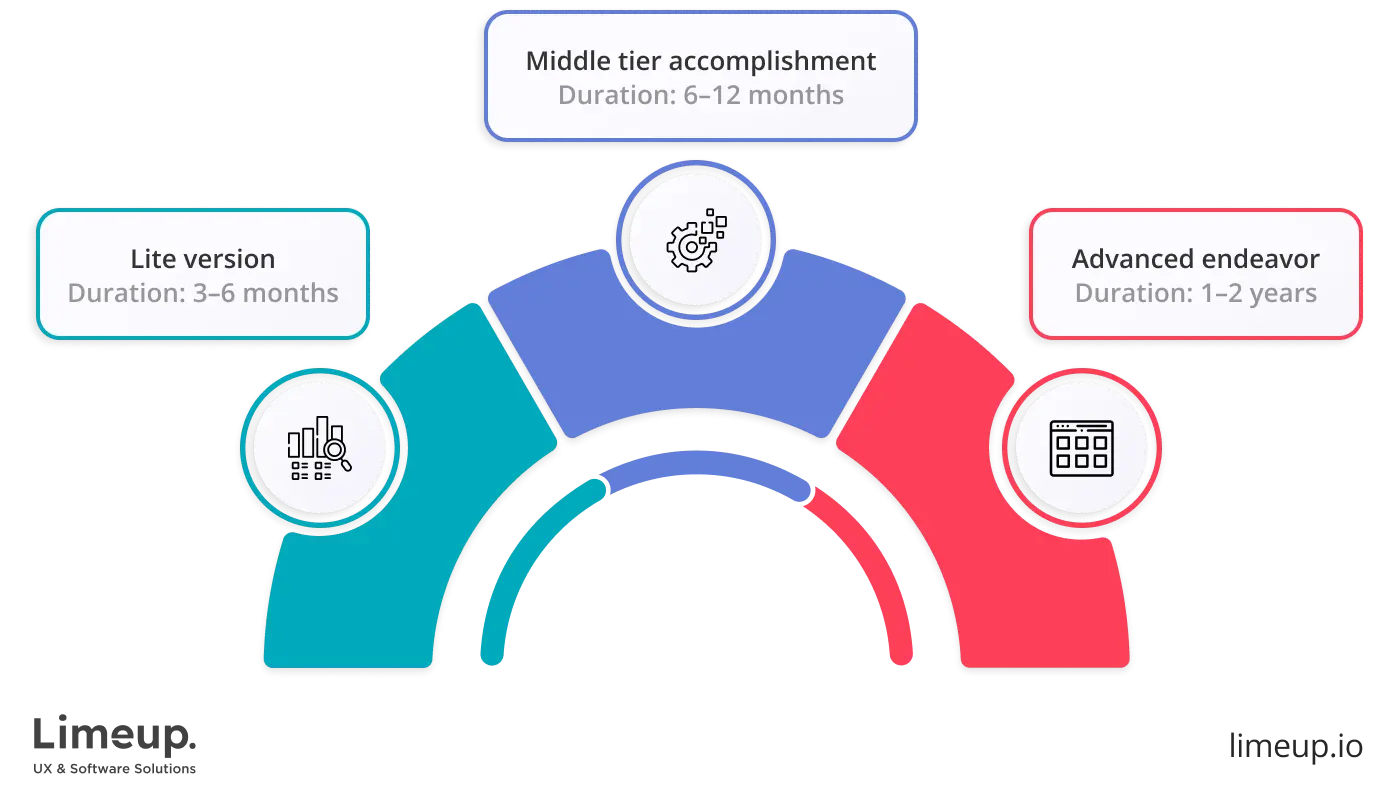
Lite version
Project length: 3–6 months
Core features: Parameters are limited to basic sets of configurations. Healthcare app developers design instruments that enable people to receive regular reminders like drinking water, walking, training or taking pills. They also count some metrics like steps, calories and so on. After installation, participants are given the possibility of registering an account in order to save their progress. However, there are no multilayered connections with external vendors.
Things to say: The course can be extended if, for example, your program collects vital signs statistics; it has to obey the rules that, as a result, prolong the wrap-up of your initiative. This variation of delivery may appear as a complete undertaking or be presented as an MVP to gather some feedback from early adopters.
Middle tier accomplishment
Duration: 6–12 months
Specifications: Healthcare apps development of this caliber greatly exceeds the starter level since they open many more doors to operate with essentials. Building a seamless utility that permits doctors and their patients to conduct remote sessions takes twice as long to finalize it.
Note to remember: The difference that elongates the drafting of a delivery like that is not only because it goes beyond observation mechanisms but also because it entails more complex frameworks as well as longer testing of performance and defense.
Advanced endeavor
Timespan: 1–2 years
Outline of workarounds: Hospital app development of this scale is like night and day if compared to the previously mentioned. They are not just simple trackers working on the sensors but next-get advancements that give an opportunity to connect systems with special devices like those that measure the level of sugar in blood or complex diagnoses of illnesses, including skin cancer, based on the photos uploaded by users.
Strategic factors: Such an intricate matter needs skilled specialists to be sped up as it is engineered with the inclusion of various libraries, and external services. The described above functions demand accurate analytic implementations, capable of processing tons of media in order to generate recommendations or even warning signs if it decides that there is a threat to a person’s good condition.
Additionally, let’s discuss the points of medical mobile app development that can impact slowing down or accelerating the meeting of your objectives regarding constructing smartphone-based utilities:
-
Specialized knowledge — you are for sure interested in getting the outcomes as soon as possible as that long timeframe will only impact the budget. What is important is that not every team of coders is proficient enough to reach all your planned benchmarks within the agreed cutoff because the regulations in this domain are quite strict, especially if we talk about the provisions of the moderate and enterprise grades.
The answer is initially to contact those innovative firms that possess the necessary competencies.
-
Engineering method — the tech world is actively working on hastening the procedure of health app development by forming refinements like cross-platform code writing or templates, saving an enormous amount of hours when a project progresses. However, when approaching native methodologies, you must be ready to face further target dates.
The choice mainly depends on the customizations that should be done. If they are limited, you can count on shortening the span.
-
Number of experts — if you don’t want to wait many months but refuse to sacrifice the quality, pay attention to the chances given by dedicated squads of programmers, whom you hire for certain periods and who commit themselves to enhancing your undertaking exclusively.
A strong and accomplished crew is the key to entering the market and grasping the share you are targeted at.
In conclusion, consider that executing a project is lengthy anyway due to countless provisions, so weigh all the options carefully.
Latest trends in app development for the healthcare industry
Mobile app development companies in the UK are making waves, adopting forward-thinking trends, transforming how supplies are delivered and experienced. Let’s jump into some of the leading directions within the programming field:
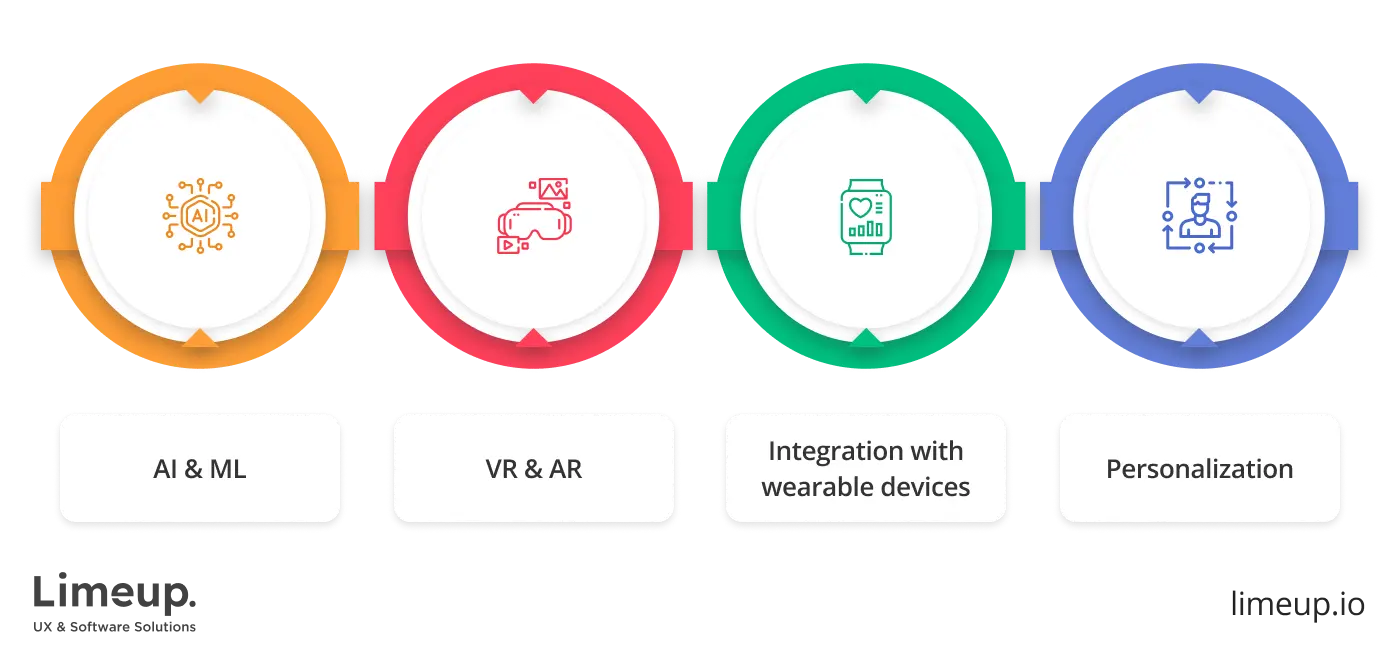
Artificial intelligence and machine learning are disrupting engineering by allowing smartphone utilities to forecast people’s conditions, recommend personalized remedial strategies and handle administrative processes with ease. Automated chatbots substantially help by providing instant responses to frequent questions or symptoms, easing the burden on hospital workers.
Mobile-based platforms now have the ability to sort through immense amounts of data to predict risks, from chronic conditions like heart disease to metabolic disorders, namely diabetes, providing an opportunity for early intervention. Additionally AI’s role in automating diagnoses, particularly through image recognition, is accelerating the accuracy and pace of evaluations.
Virtual (VR) and augmented reality (AR) healthcare application development are making tremendous strides in healing, particularly for training and treatment. Doctors are able to use VR to rehearse delicate surgeries without the risk involved. Meanwhile, AR is improving surgical outcomes by making it easier to perceive the state of a person up-to-the-minute.
On the side of a service receiver, AR programs allow for immersive, interactive experiences that make complex information about drugs and procedures more approachable and easier to comprehend, for example, assisting in explaining treatments, recovery cycles and surgeries. The decision to build a healthcare app with AR can go a long road toward making the patients familiar with or understand your offer and happy about using it.
As sensitive files go digital, the demand for secure, foolproof systems grows stronger. Blockchain mechanism proposes a strong solution to unauthorized disclosures. This decentralization of mobile health app development makes this kind of alteration or hacking impossible.
Additionally, technology may open up details about how shared diagnostic files with various health service vendors are done, assuring the quality of input and preventing fraudulent activities.
Such an ecosystem integrates with wearable devices like smartwatches and high-precision monitors. These accessories collect valuable details incorporating heart rate, blood pressure, sleep patterns and physical activity levels and use this information to offer tailored insights, reminders and alerts.
This tendency gives the seekers of clinical intervention the power to actively manage their well-rounded lives, while doctors have access to real-time states for more precise and informed decisions. Healthcare app development companies are fine-tuning the connectivity of devices like the Apple Watch, Fitbit and other IoT tools, ascertaining a more well-rounded understanding of a person’s journey.
People today seek hubs that are adjusted to their individual needs and offer customized benefits. This movement toward personalization in healthcare mobile app development services is powered by analytics, which helps script-suited treatment plans, medication reminders, and fitness recommendations.
With a more shaped tactic, therapy gateways foster greater engagement and improve overall results. From tracking mental well-being to offering targeted dietary advice, these programs are quickly becoming a staple.
Summing up
To wrap it all up, the world of E-health enhancement is no stranger to emerging progress and this points to the reinventing clinic assistance completely rested on adaptability changes.
Blend attributes such as telecare, wellness assessment and secure entry to records transforms the course of efficiency and accessibility. Set to grow exponentially, now is the right moment to take advantage of this opportunity and invest in software solutions that lift the satisfaction of each party significantly.
Here at Limeup we understand that taking the right steps in healthcare mobile application development may be tricky. Our tech gurus attend to everything from regulatory alignment to making electronic interaction easy for consumers. Whether you are building an online consultation hub or a portable assistant, our team can help you take the next action toward your vision, with protection and usability in the essence of it.
Don’t get lost in the shuffle with your ideas. Reach out to Limeup and talk to us about how we may craft a groundbreaking virtual advancement that’s just perfect for you. We will work together to uncover the power of digital know-how and create a medical app to fit your objectives.

